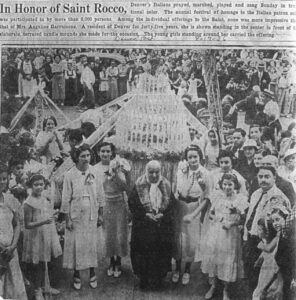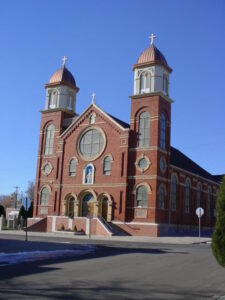By Rebecca A. Hunt
Denver’s Italian community centered on the area between 32nd and 38th avenues along Navajo Street. In the 1930s, many people still spoke Italian and some older women still wore their traditional white headdresses and gold hoop earrings.

Food production, purchasing and consumption brought people together. Many backyards had individual wood-fired ovens, and most blocks also had a communal oven so the women could gather and bake the 6-foot-long loaves of bread that were a part of daily meals.
Along Navajo Street, the Alimentari stood on corners, with windows full of hanging sausages and hams, crates with fresh and dried fruits, jars of olives and olive oil, and it all was redolent with garlic and fresh bread.
Restaurants, bars, pool halls and bakeries stood alongside houses, mixing public and private spaces. Throughout the first 30 years of the 1900s, vegetable peddlers sold their produce, some grown in the neighborhood, to shops on Navajo, at farmer’s markets, to wholesalers and along neighborhood streets.
In 1932, Rocco Malpede had a regular route that included far away Capitol Hill. By 1900, many Italians and Italian-Americans operated businesses that served the broader Denver society, businesses that were often located outside of the community core.
One example was Teodoro Zadro, who was born in Trento, Italy, in 1876 and came to the U.S. in 1899. He spent several years in Rock Springs, Wyoming, as a coal miner before he moved to Denver. His American-born wife, Lina Anselmi, was part of a large Italian family in Rock Springs. In 1930, Teodoro ran both the Ogden Theatre on Capitol Hill in Denver and the Liberty Bell Theatre in Leadville.

Our Lady of Mount Carmel Church, which now stands at 36th Avenue and Navajo Street, was at the heart of the north Denver community. In 1891, Father Mariano Lepore, Giacomo di Giacomo, Michael Notary and John Domenico formed the Our Lady of Mount Carmel Society. They turned to the community to raise money to build their Italian Catholic church.
Because Our Lady was the patron saint of southern Italy, she was a logical focus for the church. The small frame building, dedicated in 1894, stood at 34th Avenue and Navajo Street. It served the parish until it burned under suspicious circumstances in 1898. Almost immediately, the congregation began to rebuild.
At that point, the tensions that were simmering between those who liked Father Lepore and those who did not erupted in arguments about the new structure. In the end the dissenters, led by the wealthy Damascio and Notary families, built their own church, named The Chapel of St. Rocco at 36th Avenue and Osage Street.
After Bishop Nicholas Matz refused to send them a priest or even consecrate the chapel, the rebels considered affiliating with the Greek Orthodox Church or even with a Protestant denomination. Most of the breakaway group went back to Mount Carmel.
The building stood empty until the Mount Carmel group bought it to be the first parish school. Eventually they built a new school and then tore the former chapel down in 1955. Father Lepore laid the cornerstone for the new Mount Carmel in 1899.

In November of 1903, members of the church called Denver police to report a murder. Father Mariano Lepore lay dead next to the body of a young man recently arrived from Potenza. The police ruled that the newcomer shot the priest and then turned the gun on himself.
Father Lepore’s death ended four years of arguments, centered on the church, about who would wield power in Denver’s Italian colony. Finally, in 1904, Bishop Matz dedicated the new brick Mount Carmel Church and brought in the Servite Brothers to serve Denver’s Italian-Americans.
Through the years, the feasts of San Rocco Day and the Annunciation were two of the most important holy days in the community. They featured processions with the priests in full robes, lay leaders processing, with those who gave the largest donations to the church leading the way. Beginning in the 1910s, younger Italian-Americans began to move out to new bungalows on the vacant lots of the Highlands. New homes also began to appear in Sunnyside, on the open land north of 38th Avenue, as well as new houses built in West Highland and Berkeley west of Federal Boulevard, from 32nd to 48th avenues.
After World War II, many of the third-generation Italians moved out to the new towns of Arvada, Wheatridge, Broomfield, Northglenn, Thornton and Westminster. Some of them established small businesses along 38th and 44th avenues between Navajo and Sheridan.
But these migrants and their offspring returned to the northside for baptisms, marriages, burials and other celebrations of the community. So, the connection continued and life went on.
Dr. Rebecca A. Hunt has been a Denver resident since 1985. She worked in museums and then taught Colorado, Denver and immigration history at the University of Colorado Denver until she retired in 2020.

Be the first to comment